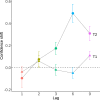Temporal attention causes systematic biases in visual confidence
- PMID: 31406265
- PMCID: PMC6690997
- DOI: 10.1038/s41598-019-48063-x
Temporal attention causes systematic biases in visual confidence
Abstract
Temporal attention enhances the perceptual representation of a stimulus at a particular point in time. The number of possible attentional episodes in a given period is limited, but whether observers' confidence reflects such limitations is still unclear. To investigate this issue, we adapted an "Attentional Blink" paradigm, presenting observers with a rapid visual stream of letters containing two targets cued for subsequent perceptual reports and confidence judgments. We found three main results. First, when two targets fell within the same attentional episode, the second target underwent a strong under-confidence bias. In other words, confidence neglected that a single attentional episode can benefit to both targets. Second, despite this initial bias, confidence was strongly correlated with response probability. Third, as confidence was yoked to the evidence used in perceptual reports, it remains blind to delays in response selection for the second target. Notably, the second target was often mistaken with a later item associated with higher confidence. These results suggest that confidence does not perfectly evaluate the limits of temporal attention in challenging situations.
Conflict of interest statement
The authors declare no competing interests.
Figures





Similar articles
-
The role of the magnocellular visual pathway in the attentional blink.Brain Cogn. 2012 Mar;78(2):99-104. doi: 10.1016/j.bandc.2011.12.002. Epub 2012 Jan 2. Brain Cogn. 2012. PMID: 22218296
-
Differential Contributions of GABA Concentration in Frontal and Parietal Regions to Individual Differences in Attentional Blink.J Neurosci. 2016 Aug 24;36(34):8895-901. doi: 10.1523/JNEUROSCI.0764-16.2016. J Neurosci. 2016. PMID: 27559171 Free PMC article.
-
Reconsidering Temporal Selection in the Attentional Blink.Psychol Sci. 2016 Aug;27(8):1146-56. doi: 10.1177/0956797616654131. Epub 2016 Jul 12. Psychol Sci. 2016. PMID: 27407133
-
Effect of emotions on temporal attention.Prog Brain Res. 2017;236:287-309. doi: 10.1016/bs.pbr.2017.08.014. Epub 2017 Oct 3. Prog Brain Res. 2017. PMID: 29157417 Review.
-
Perceptual episodes, temporal attention, and the role of cognitive control: Lessons from the attentional blink.Prog Brain Res. 2017;236:53-73. doi: 10.1016/bs.pbr.2017.07.008. Epub 2017 Sep 12. Prog Brain Res. 2017. PMID: 29157418 Review.
Cited by
-
Modelling the simultaneous encoding/serial experience theory of the perceptual moment: a blink of meta-experience.Neurosci Conscious. 2022 Mar 2;2022(1):niac003. doi: 10.1093/nc/niac003. eCollection 2022. Neurosci Conscious. 2022. PMID: 35242362 Free PMC article.
-
Consensus Goals in the Field of Visual Metacognition.Perspect Psychol Sci. 2022 Nov;17(6):1746-1765. doi: 10.1177/17456916221075615. Epub 2022 Jul 15. Perspect Psychol Sci. 2022. PMID: 35839099 Free PMC article.
-
A robust confidence-accuracy dissociation via criterion attraction.Neurosci Conscious. 2021 Nov 15;2021(1):niab039. doi: 10.1093/nc/niab039. eCollection 2021. Neurosci Conscious. 2021. PMID: 34804591 Free PMC article.
-
Confidence at the limits of human nested cognition.Neurosci Conscious. 2022 Oct 15;2022(1):niac014. doi: 10.1093/nc/niac014. eCollection 2022. Neurosci Conscious. 2022. PMID: 36267224 Free PMC article.
-
Transient Attention Gates Access Consciousness: Coupling N2pc and P3 Latencies Using Dynamic Time Warping.J Neurosci. 2024 Jun 26;44(26):e1798232024. doi: 10.1523/JNEUROSCI.1798-23.2024. J Neurosci. 2024. PMID: 38789261 Free PMC article.
References
Publication types
MeSH terms
LinkOut - more resources
Full Text Sources

